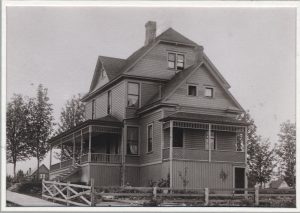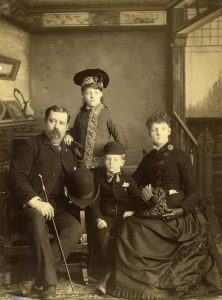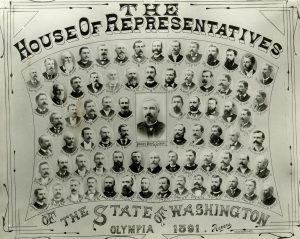Visitors entering the parlor of a typical American middle class family’s home around the turn of the century would have noticed prominent displays of photographs of the family members and their relatives. These pictures offered families a way to remember their relatives and show visitors who they were. Photography at this time was a growing  industry, with photos becoming more and more available for people of all classes. In Olympia, many of these early pictures were taken by A. D. Rogers. His images, from portraits of ordinary people to official portraits for state government, form an important record of a time gone by.
industry, with photos becoming more and more available for people of all classes. In Olympia, many of these early pictures were taken by A. D. Rogers. His images, from portraits of ordinary people to official portraits for state government, form an important record of a time gone by.
Adelbert DeLos Rogers was born on August 4, 1844, to Henry and Nancy Rogers in Tyre, New York. The family later moved to Wisconsin. On August 15, 1862, Rogers enlisted in Company C of the Wisconsin 22nd Infantry Regiment. Private Rogers was a prisoner of war for three months in Libby Prison. After he was freed, his unit was later part of General Sherman’s March to the Sea. Rogers was mustered out in Washington D.C. on June 12, 1865. He later joined the George H. Thomas post of the Grand Army of the Republic in Olympia.
Rogers returned to Wisconsin. On June 12, 1868, he married Permelia Augusta Moore (1847-1924) in Burlington. The 1870 federal census noted that the couple lived with Rogers’ parents in Janesville, Wisconsin, where father and son were working as coopers (barrel makers). Rogers and his wife soon moved to Illinois where their daughter Edna was born in 1872.

In 1876, the family moved to Albany, Oregon. A. D. Rogers became an active member of Albany’s society. In 1878, he became a founding member of the Albany group of the Ancient Order of United Workmen (AOUW). The AOUW was a post-Civil War fraternal society that offered sickness, accident, death, and burial insurance to members. As a leader of the organization, Rogers helped form new groups in nearby towns. The 1880 census records him being a painter, probably referring to house painting rather than being an artist.
The Rogers welcomed a son, Raymond, in 1880 and the family moved to Olympia the next year. Sometime A.D. Rogers learned the art of photography, and the State Library, working with the Tate Henry Rogers collection, speculate that A. D. Rogers learned from L. Wilson Clark, whose studio he bought in 1889, renaming it the A. D. Rogers Studio. Rogers was working as a photographer before 1889 and took an official group photo of the state constitutional convention in 1888. In 1890 he moved his studio from the corner of 4th and Main streets to the McKenney building on 5th and Main where he remained the rest of his career.
In 1890, Rogers was hired to take official portraits of state legislators. It was a job he did for many years, and he also took photos of the governor and other state officials. A. D. Rogers was a busy worker, taking photos seven days a week at his studio, especially during the busy Christmas and New Year seasons.

In 1890, the Rogerses built a spacious Queen Anne-style home on Maple Park in Olympia, where many of the wealthier citizens lived before the current State Capitol was constructed. The home was one of the fanciest in the city, showing how successful Rogers’ business was. In 1902, Rogers’ daughter Edna married Dr. Philip H. Carolyn, who was a state legislator from 1907 to 1929.
The Rogers were respected members of the community. A Morning Olympian article (June 12, 1898) covered their 30th wedding anniversary party at their home, praised the couple, saying that: “Mr. and Mrs. Rogers have the reputation in Olympia of presiding over a household that is proverbially hospitable. Mr. Rogers is a prince of entertainers, his jolly rollicking mirth being equal to any emergency.”
In 1906, A. D. Rogers renamed his studio Rogers and Son. Raymond had been helping him in the studio since 1902, working both as a clerk and retouching photos. In 1908, Raymond married Tate Henry (1885-1979). The couple soon moved to Aberdeen where Raymond worked for the Daily World newspaper, leaving Rogers to run the business with assistants who helped with the business and acted as apprentices to learn photography.

In declining health, Rogers retired and sold his studio to Jennie Chambers on June 1, 1911. Chambers had been his assistant for nine years. A. D. told the local papers that he planned to take outdoor photographs and tend to the large flock of chickens at his home. Chambers operated the studio for a time under her own name, but sold out to O. U. Roberts in 1914.
D. Rogers died June 5, 1917, in Olympia and was laid to rest at Tumwater’s Masonic Cemetery. The local Grand Army of the Republic officiated at the funeral. Some of his photographs reside in various collections including the Washington State Archives, University of Washington and Washington State Historical Society. They form an irreplaceable record of time gone by and a legacy continued by the modern photographers of Thurston County today.


















































